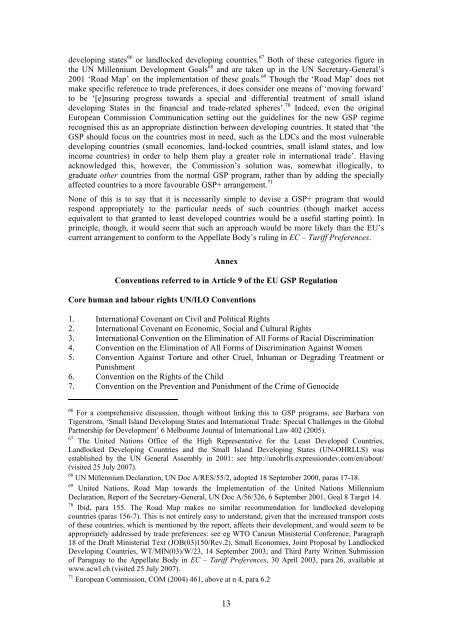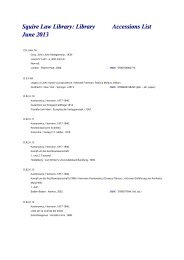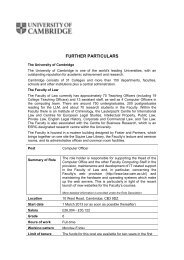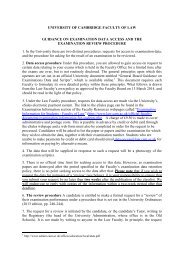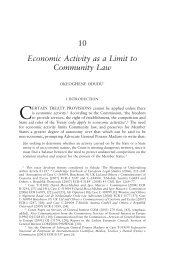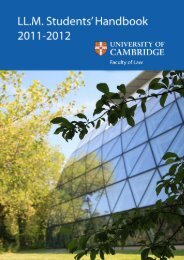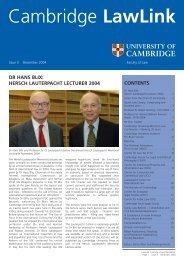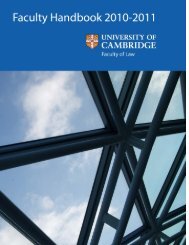The WTO legality of the EU's GSP+ arrangement Dr Lorand Bartels ...
The WTO legality of the EU's GSP+ arrangement Dr Lorand Bartels ...
The WTO legality of the EU's GSP+ arrangement Dr Lorand Bartels ...
You also want an ePaper? Increase the reach of your titles
YUMPU automatically turns print PDFs into web optimized ePapers that Google loves.
developing states 66 or landlocked developing countries. 67 Both <strong>of</strong> <strong>the</strong>se categories figure in<strong>the</strong> UN Millennium Development Goals 68 and are taken up in <strong>the</strong> UN Secretary-General’s2001 ‘Road Map’ on <strong>the</strong> implementation <strong>of</strong> <strong>the</strong>se goals. 69 Though <strong>the</strong> ‘Road Map’ does notmake specific reference to trade preferences, it does consider one means <strong>of</strong> ‘moving forward’to be ‘[e]nsuring progress towards a special and differential treatment <strong>of</strong> small islanddeveloping States in <strong>the</strong> financial and trade-related spheres’. 70 Indeed, even <strong>the</strong> originalEuropean Commission Communication setting out <strong>the</strong> guidelines for <strong>the</strong> new GSP regimerecognised this as an appropriate distinction between developing countries. It stated that ‘<strong>the</strong>GSP should focus on <strong>the</strong> countries most in need, such as <strong>the</strong> LDCs and <strong>the</strong> most vulnerabledeveloping countries (small economies, land-locked countries, small island states, and lowincome countries) in order to help <strong>the</strong>m play a greater role in international trade’. Havingacknowledged this, however, <strong>the</strong> Commission’s solution was, somewhat illogically, tograduate o<strong>the</strong>r countries from <strong>the</strong> normal GSP program, ra<strong>the</strong>r than by adding <strong>the</strong> speciallyaffected countries to a more favourable <strong>GSP+</strong> <strong>arrangement</strong>. 71None <strong>of</strong> this is to say that it is necessarily simple to devise a <strong>GSP+</strong> program that wouldrespond appropriately to <strong>the</strong> particular needs <strong>of</strong> such countries (though market accessequivalent to that granted to least developed countries would be a useful starting point). Inprinciple, though, it would seem that such an approach would be more likely than <strong>the</strong> EU’scurrent <strong>arrangement</strong> to conform to <strong>the</strong> Appellate Body’s ruling in EC – Tariff Preferences.AnnexConventions referred to in Article 9 <strong>of</strong> <strong>the</strong> EU GSP RegulationCore human and labour rights UN/ILO Conventions1. International Covenant on Civil and Political Rights2. International Covenant on Economic, Social and Cultural Rights3. International Convention on <strong>the</strong> Elimination <strong>of</strong> All Forms <strong>of</strong> Racial Discrimination4. Convention on <strong>the</strong> Elimination <strong>of</strong> All Forms <strong>of</strong> Discrimination Against Women5. Convention Against Torture and o<strong>the</strong>r Cruel, Inhuman or Degrading Treatment orPunishment6. Convention on <strong>the</strong> Rights <strong>of</strong> <strong>the</strong> Child7. Convention on <strong>the</strong> Prevention and Punishment <strong>of</strong> <strong>the</strong> Crime <strong>of</strong> Genocide66 For a comprehensive discussion, though without linking this to GSP programs, see Barbara vonTigerstrom, ‘Small Island Developing States and International Trade: Special Challenges in <strong>the</strong> GlobalPartnership for Development’ 6 Melbourne Journal <strong>of</strong> International Law 402 (2005).67 <strong>The</strong> United Nations Office <strong>of</strong> <strong>the</strong> High Representative for <strong>the</strong> Least Developed Countries,Landlocked Developing Countries and <strong>the</strong> Small Island Developing States (UN-OHRLLS) wasestablished by <strong>the</strong> UN General Assembly in 2001: see http://unohrlls.expressiondev.com/en/about/(visited 25 July 2007).68 UN Millennium Declaration, UN Doc A/RES/55/2, adopted 18 September 2000, paras 17-18.69 United Nations, Road Map towards <strong>the</strong> Implementation <strong>of</strong> <strong>the</strong> United Nations MillenniumDeclaration, Report <strong>of</strong> <strong>the</strong> Secretary-General, UN Doc A/56/326, 6 September 2001, Goal 8 Target 14.70 Ibid, para 155. <strong>The</strong> Road Map makes no similar recommendation for landlocked developingcountries (paras 156-7). This is not entirely easy to understand, given that <strong>the</strong> increased transport costs<strong>of</strong> <strong>the</strong>se countries, which is mentioned by <strong>the</strong> report, affects <strong>the</strong>ir development, and would seem to beappropriately addressed by trade preferences: see eg <strong>WTO</strong> Cancun Ministerial Conference, Paragraph18 <strong>of</strong> <strong>the</strong> <strong>Dr</strong>aft Ministerial Text (JOB(03)150/Rev.2), Small Economies, Joint Proposal by LandlockedDeveloping Countries, WT/MIN(03)/W/23, 14 September 2003; and Third Party Written Submission<strong>of</strong> Paraguay to <strong>the</strong> Appellate Body in EC – Tariff Preferences, 30 April 2003, para 26, available atwww.acwl.ch (visited 25 July 2007).71 European Commission, COM (2004) 461, above at n 4, para 6.213


